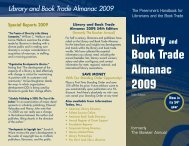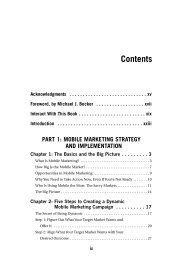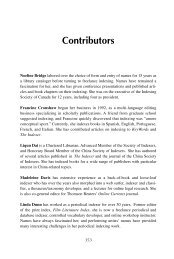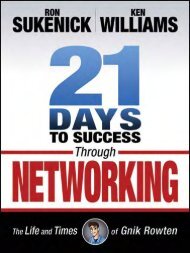Sample Chapter - Books
Sample Chapter - Books
Sample Chapter - Books
- No tags were found...
Create successful ePaper yourself
Turn your PDF publications into a flip-book with our unique Google optimized e-Paper software.
Seven-Problem Approach to Indexing Names 3it would take a book in itself. Advice is plentiful via the many names indexingresources and throughout this book.In order to decide whether to index under a prefix or a following element, onehas to know which element is a prefix. This presents a challenge, especially withnames containing several words of titles and family and clan information, as withthe Arab and Indonesian names explored in this book by Heather Hedden andMadeleine Davis, in <strong>Chapter</strong> 3 and <strong>Chapter</strong> 11, respectively, who explain the meaningsof commonly occurring elements of names in these societies.Some relevant questions to be answered before conducting a search are:• What nationality is the person? Differing guidelines exist forvarious countries. Also, in indexing, a lot depends on where asubject lived the most or at least dwelled for that part of his lifewritten about in the book. For example, persons with surnamesincluding prefixes living in their native countries are indexedaccording to the conventions of those countries, which oftenmeans entry under that part of the name following the prefix. Butif they lived primarily in English-speaking countries, they areindexed under the prefix.• What time period is involved? The ordering of the elements ofnames has often changed over time, with direct order evolving toinverted order.The following three questions are related:• What is the audience for the book? The age level of the readershipcan come into play here. I am in favor of using the conventionalorder for all names, the one to be found in library catalogs andreference books; children should be getting used to consultingthese titles.• What is the genre of the book? Academic works often call for astrictly conventional form of entry, unlike trade books ortextbooks.• Are there pertinent publisher guidelines and author preferences?In my experience, most publishers do not provide such detail intheir own guidelines. They may, however, point to style guides,such as the Chicago Manual of Style or Hart’s Rules, even citing aparticular edition. Author’s preferences may be gauged by usage inthe book; I’ve had academic authors contact me to make sure Iwill index the names of persons in their books by certainguidelines, usually the most formal and fullest forms.








